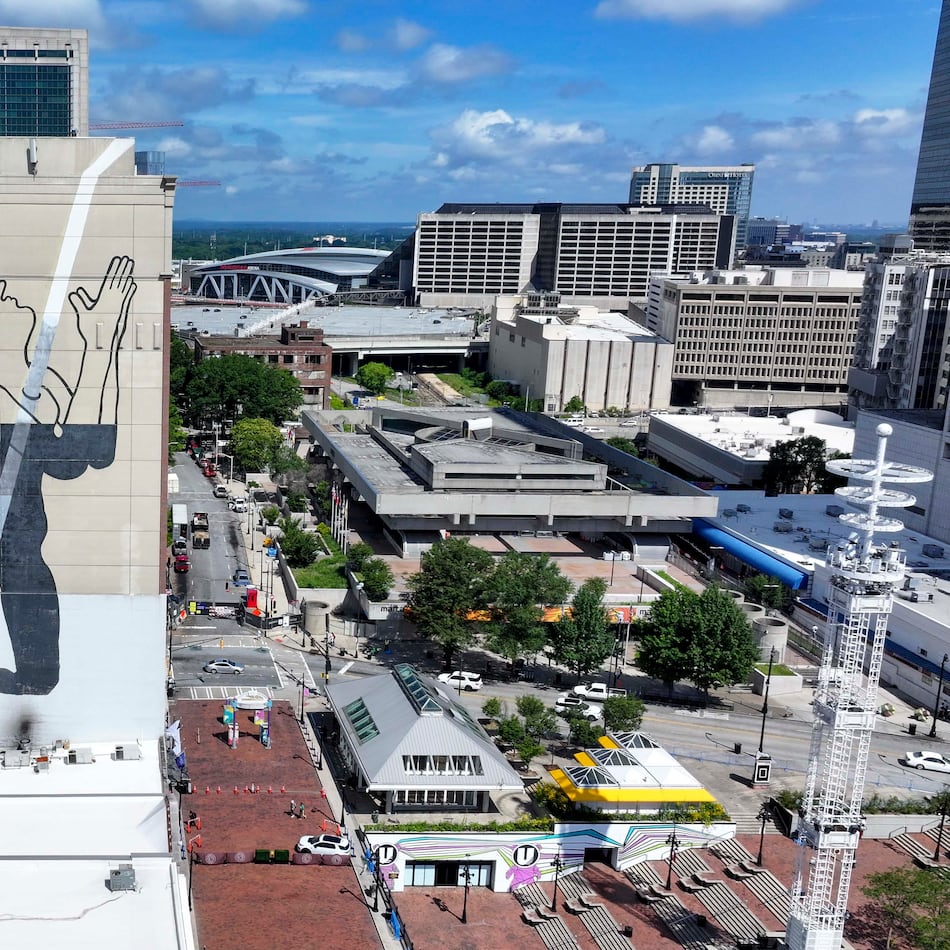Dilapidated and ruined, Briarcliff Mansion —the former home of Coca-Cola heir Asa “Buddie” Candler Jr. — rests atop 42 acres of rich history. Once the height of Atlanta society, the 40-room Atlanta mega-mansion has been slumbering for decades. Now a community developer is set to awaken the estate once again.
While the ambitious renovations are only gestating now, the news has already perked the ears of the Atlanta Preservation Center. It’s more than a former home. It’s a touchstone to one of the city’s most influential and fascinating residents.
While she works as the Director of Product Marketing at Cox Automotive during the day, Sara Butler is also a “writer with a love of old buildings and weird history.” That is what led the researcher to write a book about Asa Candler Jr. and his legendary Briarcliff Mansion.
“I was more interested in the building and wanted to understand why there was a giant, abandoned mansion in the middle of the Atlanta suburbs,” she told The Atlanta Journal-Constitution. “That was when I found out about the other Candler mansions and learned the story behind each mansion’s name. Briarcliff was the only exception. Not a single source explained why Briarcliff was called Briarcliff. So originally my intention was to find out how the property got its name and maybe write a blog about it. No big commitment. But as I like to say, in order to understand the mansion I had to understand the man, and in order to understand the man I had to understand the mansion. They’re inextricably linked, and I realized early on that the story I was uncovering went way beyond a single property.”
Candler Jr. purchased the humble property, known as Briarcliff Farm in 1912, and later devised the construction of his iconic mansion — which was not completed until 1922. In a race against his siblings, who each also took home $25 million from their Coca-Cola shares, Candler Jr. was determined to have the finest showpiece within the Candler family.
The heir would ultimately achieve his goal. Featuring the largest private magic collection in the world at the time, Candler Jr. regularly held magic shows for Atlanta high-society at the estate. He also went on to construct an exotic zoo on the property, which featured elephants, bears and more.
Candler Jr.’s wealth and ambition transformed far more than the Briarcliff Farm. It changed the capital of Georgia.
“This property represents that unique mixture of Atlanta myth and reality — that is both convenient and uncomfortable,” Atlanta Preservation Center executive director David Mitchell told The Atlanta Journal-Constitution. “You have the story of Coca-Cola commingled with our city’s airport, parks, buildings and spaces. It is everything ‘Atlanta’ that we don’t know and yet, what we feel simply is. Rarely does a structure converge to become a relic of what was — that gave birth to what we are - and embody what we can still experience — and retain its Atlanta credibility. In short - it is a historical interruption captured in a time that is gone, yet we still are connected too.”
Credit: Sara Butler
Credit: Sara Butler
Candler continued to build upon the Briarcliff Mansion Estate. The sprawling property ultimately featured servants quarters, tennis courts, a golf course, stables, a farm, greenhouses, both a private and public pool, and the estate’s fabled zoo.
The former Coca-Cola heir used everything the estate had to offer to entertain with lavish parties. It’s a story reminiscent of the title character from F. Scott Fitzgerald’s classic novel “The Great Gatsby.”
“Family lore claims that Buddie’s oldest surviving son John claimed to have lived like the Great Gatsby during his young adult years,” Butler said. “As far as Buddie’s legacy goes, you can see it in the iconic landmarks he left behind. Buddie didn’t do anything small, which a family friend noted in a statement following his passing: ‘Asa Candler, Jr., was a dreamer and a doer ... He never thought in small things, but all things which appealed to him were large in scope.’”
According to Butler, from the Hartsfield-Jackson Atlanta International Airport to Zoo Atlanta to the Fernbank Science Center, Candler Jr.’s influence has played a significant role in making the city what it is today.
“He’s the reason Atlanta has the busiest airport in the world,” she said. “He’s the reason the Clermont Hotel is named the Clermont. He gave Briarcliff Road its name, and by extension every side street and business with Briarcliff in its name. He was a major reason why the Fox Theater’s financial plan went sideways during its construction, resulting in the sale of the property to the Fox Theater company. He’s the reason we have the Westside Provisions District, which is built on the agricultural empire he attempted to launch in the late 1920s. He’s the reason why Atlanta got its original Macy’s store at 200 Peachtree (he personally drove the company’s president around Atlanta in the 1920s to prove to him that residents were well-suited for their brand).
“He sold his menagerie of animals to the Grant Park Zoo, now Zoo Atlanta, contributing to the institution we know and love today. His collection of hunting taxidermy now makes up a significant portion of the collection at Fernbank Science Center. He’s the reason we have the enormous abbey-style mausoleum at Westview Cemetery. He built the Briarcliff Hotel on Ponce, and his son built the Briarcliff Plaza across the street (via Asa Jr.’s investment company). His fingerprints are all over this city in beloved iconic locations.”
In modest words, it’s a legacy that runs deep.
But “the greatest car racing, magic performing, game hunting, dairy farming, mega-yachting, airplane flying, cemetery building, music loving, rum running, zoo keeping, celebrity hobnobber the world has never known” most fascinating legacy remains the Briarcliff Mansion — an estate full of mystery.
Credit: Sara Butler
Credit: Sara Butler
On the third floor ballroom of the home, Candler Jr. hosted his “magic soirees.” For Atlanta’s high society, it was a sight to behold. The ballroom even featured a secret door that was likely used for disappearing acts during the shows.
“These weren’t just the local guys hanging out. Buddie flew the most famous magicians from the time, like Harry Blackstone, into town in his private airplane,” Butler said. “Harry Houdini never attended because he was dead by that time, but I have hard, printed evidence that Harry Houdini and Asa Candler, Jr. did know each other and may have been friendly.
“Buddie used to claim that Houdini was one of his best friends, but the evidence and the timeline suggest something a little more superficial and, well, let’s just say Buddie liked to spin a good yarn.”
For those more interested in natural things, Candler Jr. had his menagerie of bears, elephants, lions and more exotic pets. When the former heir decided to parade his zoo through the suburban streets of Druid Hills, according to Butler, his brother Walter said “I believe this is the biggest fool thing you’ve ever done, Buddie.”
From the golf course to the pools to the solariums to the zoo to the magic shows, it was all magnificent. Candler Jr. did nothing halfway.
“The house and property were intended to be a center of socialite activity and they were constantly entertaining,” Butler said. “But appearances of high-society status were important to the Candlers. They threw parties, but they threw rich people parties. They brought in classical musicians to perform concerts on their pipe organ. They threw enormous dinner parties. They weren’t hanging from the chandeliers and doing keg stands! That said, I have evidence that Buddie participated in rum running from Cuba during prohibition, and it was no secret that he was an alcoholic whose parties were a good source of booze.”
Candler Jr.’s reputation proceeded him in the Peach State, eventually leading to the Coca-Cola heir being known for his drinking — and even for haunting the Briarcliff Mansion after his death.
“There’s a common local story about Briarcliff that claims he would get drunk and sit up on his balcony in the music hall and glower down at his guests,” Butler said. “I’ve found no evidence that suggested he would get drunk, isolate, and glower. That seems to be a modern fabrication. I’m also often told that he was a miserable drunk who now haunts the premises because it ironically became an alcoholic treatment center. But he gave up drinking at the end of the 1930s and was no longer living at Briarcliff Mansion when he passed away in 1953.”
While Candler Jr. did not pass away at his estate, someone else did. And, it was with his gun.
“I can tell you that my absolute favorite finding of this project was the discovery that there was a murder that took place at Briarcliff,” she said. “A murder-suicide. The murderer used Buddie’s personal pistol. I’ve reconstructed the night’s events and have located and visited the unmarked grave of the murderer.”
Candler Jr. met José Cruz, a magician, during a stop in the Philippines and ultimately asked the performer to move to Atlanta. Cruz would go on to become his butler and teach him magic tricks, just one of 15 servants and staff at Briarcliff Mansion at the time. On the morning of Jan. 18, 1931, Cruz’s body and the body of a young woman were found inside a vehicle on the property.
Inside, as listed on asabriarcliff.com, a note read “To whom it may concern: We, Gladys Frix and José Cruz, are taking our lives because we love each other, but due to objections of Louise Frix and Mrs. J. T. Clay we can’t find a way to be together in peace. We love each other and we rather die and be together always than to be parted from each other, and good bye to all, and may God forgive us.”
Credit: Galerie Living
Credit: Galerie Living
As the years continued, Candler Jr. ultimately sold the estate to the U.S. government — which operated a mental health hospital on the premises for some time. The property exchanged hands once again in 1997 when Emory University purchased the estate as part of a $2.9 million acquisition.
While Emory University had plans to run a biotechnology incubation center on the property, the undertaking ultimately went bust. The structures were already showing significant signs of wear and tear.
The former mental health hospital would go on to be featured in Netflix’s hit series “Stranger Things,” which is currently airing its fourth season. The mansion can also be seen in “Vampire Diaries,” “First Man,” “Doom Patrol” and other Hollywood series.
Now the estate is being leased to Galerie Living, a community development company, who is now renovating the Briarcliff Mansion to transform it into a senior living community.
“In conjunction with the development of the actual senior living community & residences on the property, the Briarcliff mansion will be fully renovated and repurposed,” Galerie Living Founder and CEO Tim Gary told The Atlanta Journal-Constitution. “The mansion will be a spectacular amenity that enables intergenerational enrichment for the community’s residents, for the Emory community and for the surrounding neighborhood.
“Galerie’s newest Corso Community, offering more than 500 units of senior housing at full completion, along with retail, dining and recreational facilities, will offer an environment for seniors and their families to find unexpected happiness every day. In addition to the common spaces, outdoor spaces and other amenities, the mansion will become a wonderful gathering place and venue for small events.”
Things are still in the early stages, but the renovation will be substantial.
“The gardens, green houses and surrounding grounds will lay a beautiful foundation for life around the Briarcliff mansion,” Gary said. “The mansion itself will be fully renovated and restored and, as we are very early in the process, we don’t have specific design & décor details fully established.”
It’s a project that has caught the attention of the Atlanta Preservation Center, who said the project’s announcement is a major win.
“The preservation of this building is the culmination of many individuals, groups and organizations hopes throughout the city,” Mitchell said. “What it means to the Atlanta Preservation Center is that the role of historic preservation continues to grow and the understanding of the craft is expanded. The greater part of this - is that this group is speaking of the preservation from the beginning of the process. This is obviously the most desired outcome, and the reality that is already established is very reassuring.”
Something about an incredibly historic Atlanta landmark being utilized to care for some of the city’s older adults feels fitting. According to Butler, it’s a role that Candler Jr. would likely have been pleased with.
“Regarding the current proposal, I think Buddie would be pleased,” she said. “He always meant for Briarcliff to be visited and appreciated by the public. He built a 9-hole golf course for Emory staff to use in their downtime. He opened his menagerie to the public and build the adjacent pool for the community to use. He built a giant laundry facility on the premises and had customers drive up to the big house to drop off their bags. He finished the grounds months before he finished the interior because he wanted people to come visit the property and enjoy it. He always intended to let people use his music hall and formal dining room for civic events.
“He felt that he was ‘giving’ Atlanta part of himself by building his grand house. I don’t mean to make him sound like a saint or a martyr. The man had issues, and often his idea of ‘gifting’ to Atlanta was him gifting to himself and using Atlanta as a way to justify his hedonism. Sometimes Atlanta didn’t love him as much as he loved Atlanta, and frankly there are some justifiable reasons why. But by and large he was a community-minded man who opened his home and wanted people to partake of his generosity. He was also a real estate developer who would have been 100% on board with the main street concept in the current designs, as well as the senior living cottages. The fact that the pool area is intended to become a garden would have suited his plans perfectly, and the open lawn area where the zoo used to reside will restore that section of the lawn to a public use that would please him.”
While the National Register of Historic Places landmark’s survival is a huge win for Atlanta history, the Atlanta Preservation Center stressed that cherishing local history does not always require such grand gestures.
“What I would impress upon everyone is that not all historic preservation is this grand or large in scale,” Mitchell said. “Some historic preservation is at your own home. Be aware if you live in a historic neighborhood, and support the local landmark districts — adhere to your preservation codes and endorse the growth of historic preservation. Not as just a practice — but as stewards and therefore making the generations that follow have connections to a larger experience and always have our city ever present.”
Candler Jr. and his Briarcliff Mansion estate continue to influence Atlanta residents. But, at the end of it all, it’s about the community — not its influencers.
“The Candlers were a huge part of this city’s history, and their homes inspire curiosity and storytelling that connect present day Atlantans with the city’s past,” Butler said. “Sometimes the best way to get a community invested in itself is by appreciating and preserving the weird, fun, inexplicable stories. We make friends with our past when we’re allowed to smile at it.”
About the Author
The Latest
Featured





